Summarize this page via
Best AI tool for writing SEO-rich blog content
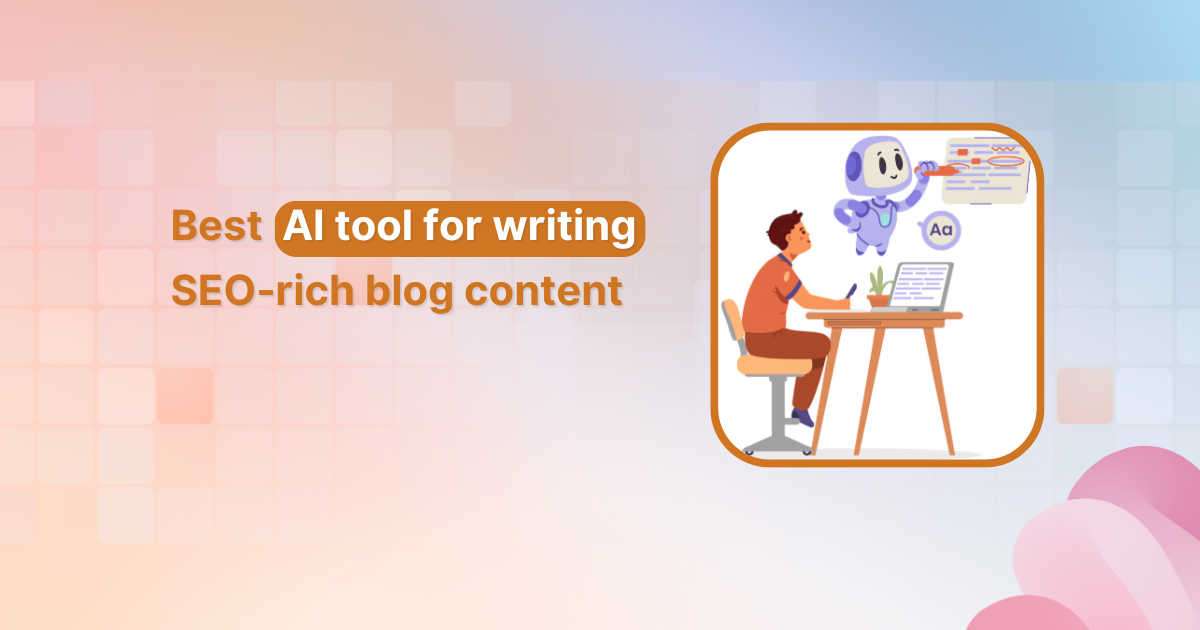
Artificial intelligence (AI) is quickly becoming the backbone of successful SEO strategies. A large majority of companies and marketers are already using AI. But the real challenge isn’t adoption. Instead, it is choosing the be st AI tool for writing SEO-rich blog content.
Among the long list of AI writing tools, Contentpen emerges as the definitive solution for creating SEO-rich blog content that ranks higher, engages readers, and drives meaningful business results.
This comprehensive guide explores what makes an AI tool truly exceptional for SEO content creation, why Contentpen stands above the competition, and how you can use its capabilities to transform your content marketing strategy.
Whether you’re a solo blogger learning how to write blogs faster using AI or managing content for a large enterprise, understanding these principles will help you create content that both search engines and human readers absolutely love.
What makes an AI tool ideal for SEO‑rich blog content?
The best AI tool for writing SEO-rich blog content must excel in three fundamental areas that separate professional-grade platforms from basic text generators.
These capabilities determine whether your content will rank on page one or get lost in the digital noise.
1. Understanding search intent and keyword placement
Modern SEO success depends on matching content to user intent, not just cramming keywords into paragraphs. The most effective AI tools analyze SERP features to understand what searchers actually want when they type specific queries.
How advanced AI tools analyze search intent
Professional platforms examine multiple data sources to understand user needs:
- “People Also Ask” questions: Reveals related concerns and subtopics users want covered
- Related search suggestions: Shows semantic variations and related queries
- Current ranking content types: Identifies whether users prefer guides, comparisons, or quick answers
- SERP features present: Indicates if Google expects videos, images, or specific content formats
Four types of search intent
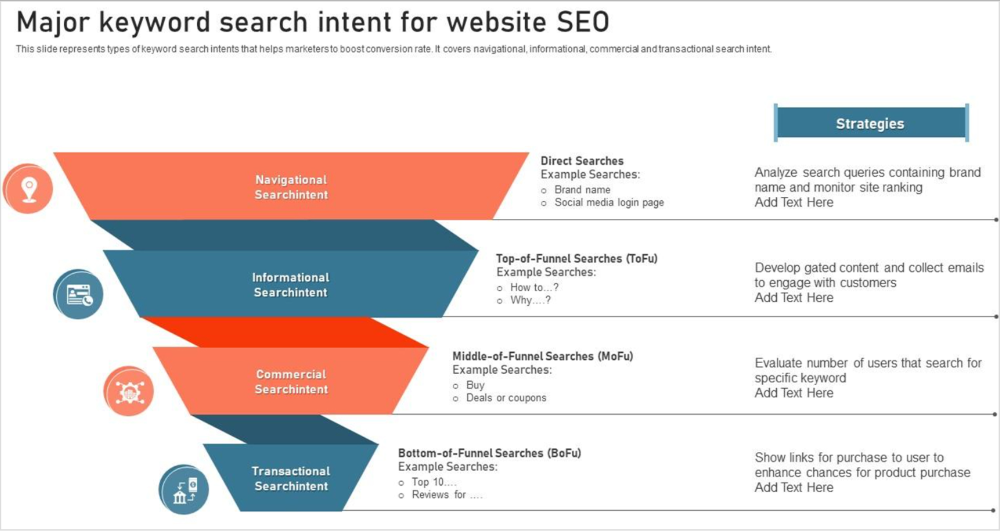
Search intent analysis has become the most critical differentiator among AI SEO tools. Advanced platforms categorize queries into four distinct types:
- Informational: Users seeking knowledge or answers to questions
- Navigational: Users looking for specific websites or brands
- Transactional: Users ready to make purchases or take action
- Commercial investigation: Users comparing options before buying
For instance, when someone searches for “best AI tool for writing SEO rich blog content,” they want comparative analysis and actionable recommendations, which is exactly what this article provides.
Smart keyword integration techniques
Professional AI tools understand semantic density and keyword relationships within context:
- Natural keyword weaving: Incorporates target terms organically within sentences
- Optimal density maintenance: Maintains the recommended 2-3% keyword density
- Semantic variations: Uses related terms to strengthen topical relevance
- Contextual placement: Positions keywords where they feel natural and valuable
This approach helps writers avoid AI detection in writing while maintaining SEO effectiveness.
2. Ensuring readability and engagement for humans and search engines
The dual challenge of SEO content lies in satisfying both algorithmic requirements and human preferences. Google’s algorithms increasingly prioritize user engagement metrics like time on page, bounce rate, and social shares. These are all indicators that real people find your content valuable.
Content structure optimization
Exceptional AI tools structure content for maximum readability using proven formatting techniques:
Heading hierarchies:
- H1 for main title with primary keyword
- H2 for major sections with secondary keywords
- H3 for subsections and detailed points
- H4-H6 for additional organization as needed
Scannable formatting elements:
- Strategic bullet points that highlight key information
- Natural paragraph breaks every 2-3 sentences
- Bold text for important concepts and keywords
- Tables and lists for complex data presentation
Also read: How to structure a blog?
Technical SEO optimization features
Content optimization extends beyond basic formatting to include essential technical elements:
| SEO element | Optimal length | Purpose |
| Meta descriptions | 155 characters | Improve click-through rates |
| Title tags | Under 60 characters | Compelling headlines that rank |
| Internal links | 3-5 per article | Keep readers engaged longer |
| Schema markup | As needed | Enhanced SERP appearance |
3. Streamlining your workflow for consistency
Enterprise-level content production requires systematic processes that maintain quality while scaling output. The most valuable AI tools integrate into existing workflows, providing collaborative features that support team-based content creation without sacrificing brand consistency.
Team collaboration features
Modern platforms offer comprehensive collaboration capabilities:
- Multi-user editing like Google Docs
- Live cursor tracking and user presence
- Instant save and sync across devices
- Version history and change tracking
- Comment systems for feedback and suggestions
- Approval workflows for quality control
- Task assignment and deadline tracking
- Role-based permission management
Brand consistency maintenance
Professional AI tools ensure every piece of content reflects your unique brand personality:
- Customizable style guides: Define tone, brand voice, and messaging parameters
- Brand voice learning: AI adapts to your preferred communication style
- Terminology management: Consistent use of industry-specific language
- Template creation: Standardized formats for different content types
Workflow automation benefits
Workflow optimization includes advanced features that transform content marketing into a data-driven process:
- Content calendar integration: Schedule and plan content strategically
- Automated publishing: Direct posting to CMS platforms
- Performance tracking: Connect content creation to business outcomes
- Analytics integration: Monitor engagement and optimization opportunities
This systematic approach transforms content marketing from a creative guessing game into a predictable growth engine.
Why Contentpen is the best AI tool for writing SEO-rich blog content?
After extensive analysis of the available AI writing tools, Contentpen consistently outperforms alternatives in the specific areas that matter most for SEO content success.
Here’s why it’s become the preferred choice for businesses serious about organic search dominance.
Many organizations struggle with the dos and don’ts of using AI to generate blog content, but Contentpen addresses these challenges through its specialized approach.
SEO‑driven outline and structure generator
Contentpen’s outline generation feature represents a quantum leap beyond basic content planning tools. It analyzes top-ranking competitors for your target keywords, identifies content gaps in the current SERP landscape, and creates comprehensive article structures that position your content for search success.
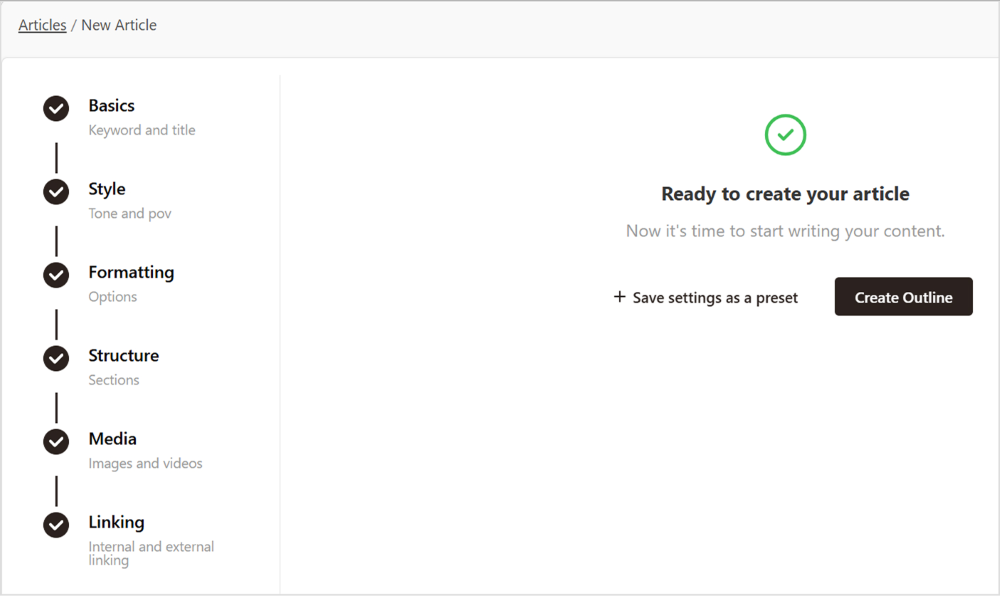
The platform’s deep topic research capabilities include automated SERP analysis of top-ranking pages, helping you understand exactly what type of content Google rewards for your specific keywords.
This research-driven approach ensures your content covers all the subtopics and semantic keywords that search engines expect, while identifying opportunities to provide unique value that competitors miss.

Each outline includes optimized heading structures that improve both SEO performance and user experience. The system suggests H1, H2, and H3 tags that create logical information hierarchies while incorporating your target keywords naturally. This strategic approach to content architecture often determines the difference between page one rankings and digital obscurity.
Built‑in keyword optimization guidance
Unlike generic AI writing tools that treat keywords as afterthoughts, Contentpen integrates keyword optimization throughout the entire content creation process. The platform provides real-time guidance on keyword density, semantic variations, and strategic placement that maximizes SEO impact without compromising readability.
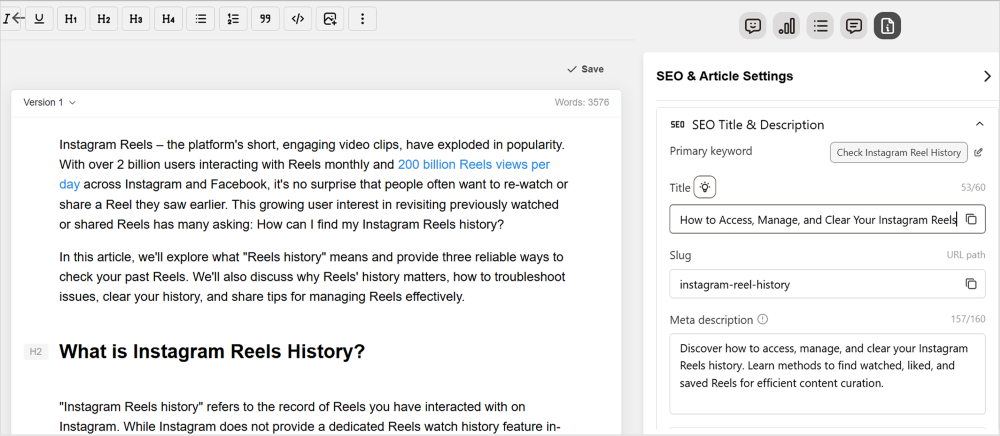
The system’s semantic analysis goes far beyond simple keyword matching. It understands the relationships between related terms and suggests contextually relevant variations that strengthen your content’s topical authority. This sophisticated approach helps your articles rank for dozens of related keywords beyond your primary target.
Linking automation
Linking automation represents another significant advantage of using Contentpen. It analyzes your existing content library and suggests strategic internal links that boost page authority and improve user engagement. This feature alone can dramatically improve your site’s overall SEO performance by creating stronger topical clusters and keeping readers engaged longer.
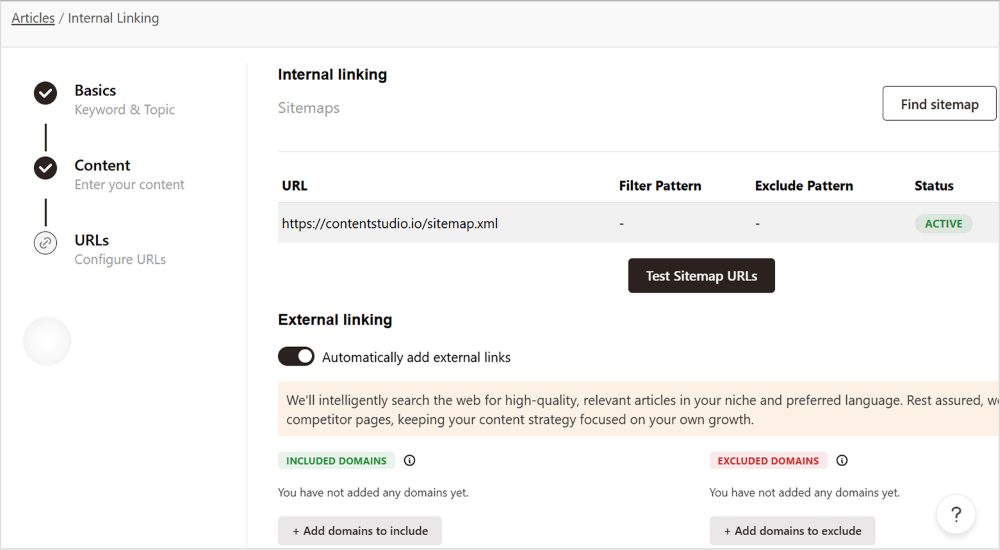
Related: What is content automation: Key benefits, tools and tips
Natural, human‑like tone and style options
One of the biggest challenges with AI-generated content is overcoming the robotic, formulaic tone that immediately signals artificial origin to readers. Contentpen addresses this through advanced natural language processing that produces genuinely engaging, conversational content.
The platform offers multiple tone options that can be fine-tuned to match your brand voice perfectly. Whether you need authoritative expertise for B2B audiences or friendly accessibility for consumer content, the system adapts its writing style while maintaining SEO optimization throughout.
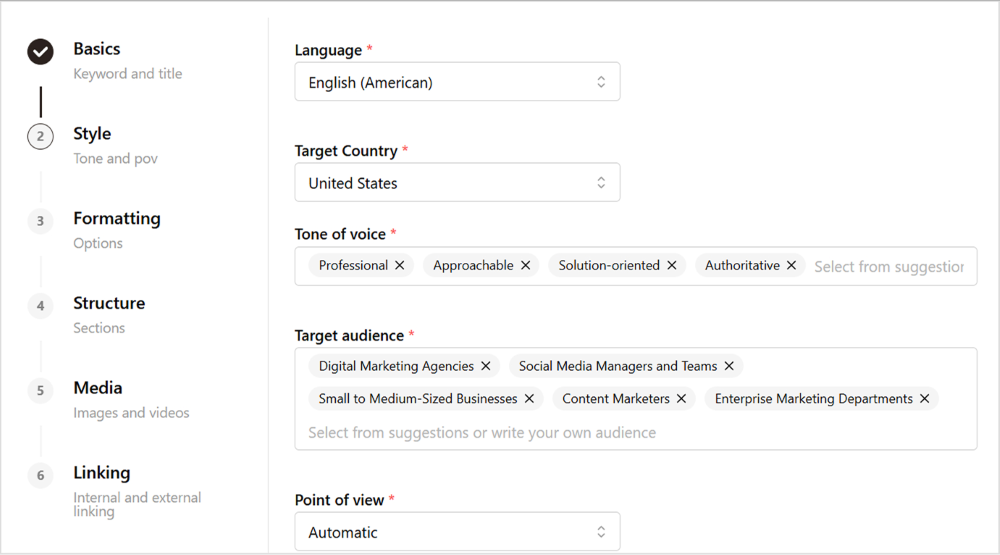
Brand voice consistency becomes effortless through Contentpen’s learning capabilities. The more you use the platform, the better it understands your preferred style, terminology, and messaging approach. This creates a feedback loop that continuously improves content quality while reducing the time needed for editing and revision.
Also read: How to build a brand voice for Contentpen?
Collaboration and publishing ease
Content marketing success requires seamless collaboration between writers, editors, SEO specialists, and marketing managers. Contentpen facilitates this through intuitive collaboration features that eliminate the friction typically associated with team-based content production.
The platform’s approval workflow system ensures quality control while maintaining publication schedules. Team members can provide feedback, suggest revisions, and approve content through a streamlined process that prevents bottlenecks and miscommunication.
Direct publishing integration with WordPress eliminates the tedious copy-paste process that wastes time and introduces formatting errors. Content flows seamlessly from creation to publication, complete with optimized meta tags, structured data, and internal links that maximize SEO impact from day one.
Related: How to connect your WordPress with Contentpen?
How to create SEO‑optimized blogs with Contentpen?
Maximizing Contentpen’s capabilities requires a systematic approach that uses each feature strategically. This step-by-step process ensures consistently excellent results while minimizing the time investment required.
Many users find that following a structured approach helps them create blog content in 10 minutes while maintaining quality standards.
Step 1: Select your keyword and target audience
Begin every content project by clearly defining your primary keyword and target audience demographics. Contentpen’s keyword research tools help identify high-opportunity terms with reasonable competition levels and strong commercial intent.
Primary keyword selection should balance search volume with ranking difficulty based on your domain authority. The platform provides keyword difficulty scores that help you choose targets you can realistically rank for within your timeline and resource constraints.
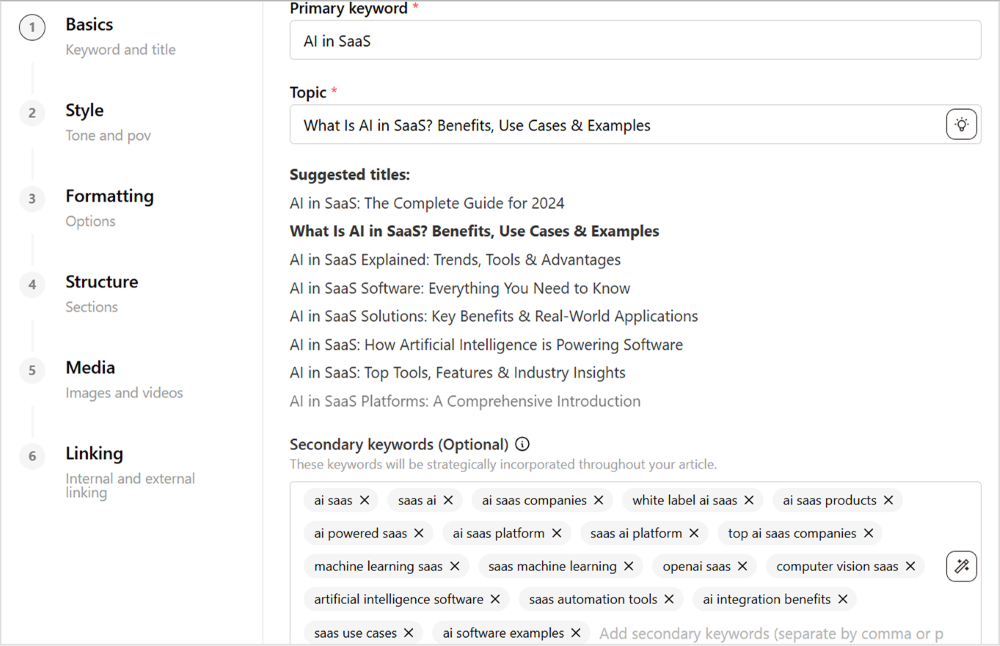
Step 2: Use Contentpen to generate an optimized outline
The outline generation phase sets the foundation for SEO success. Input your target keyword and audience parameters, then allow Contentpen’s AI agents to analyze competitor content, identify semantic keywords, and create a comprehensive content structure.
Outline optimization includes strategic heading placement that incorporates target keywords naturally while maintaining logical information flow. The system suggests subtopics that comprehensive coverage requires, helping you create pillar content that establishes topical authority.
Review and customize the generated outline to ensure it aligns with your unique value proposition and brand messaging. While the AI provides excellent structural foundations, your industry expertise and brand personality should guide the final content direction.
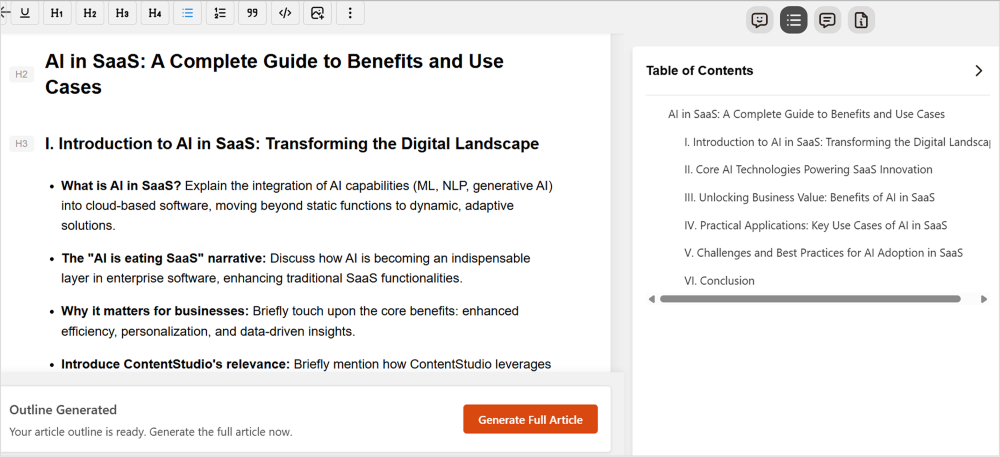
Step 3: Draft the blog with AI suggestions
Contentpen’s writing phase combines artificial intelligence efficiency with strategic SEO integration. The platform generates comprehensive content for each outline section while maintaining a consistent tone and incorporating semantic keywords naturally throughout.
The AI writing suggestions adapt to your brand voice and industry terminology, creating content that sounds authentically human while meeting all SEO criteria. This balance between optimization and authenticity is crucial for content that performs well in both search rankings and user engagement.
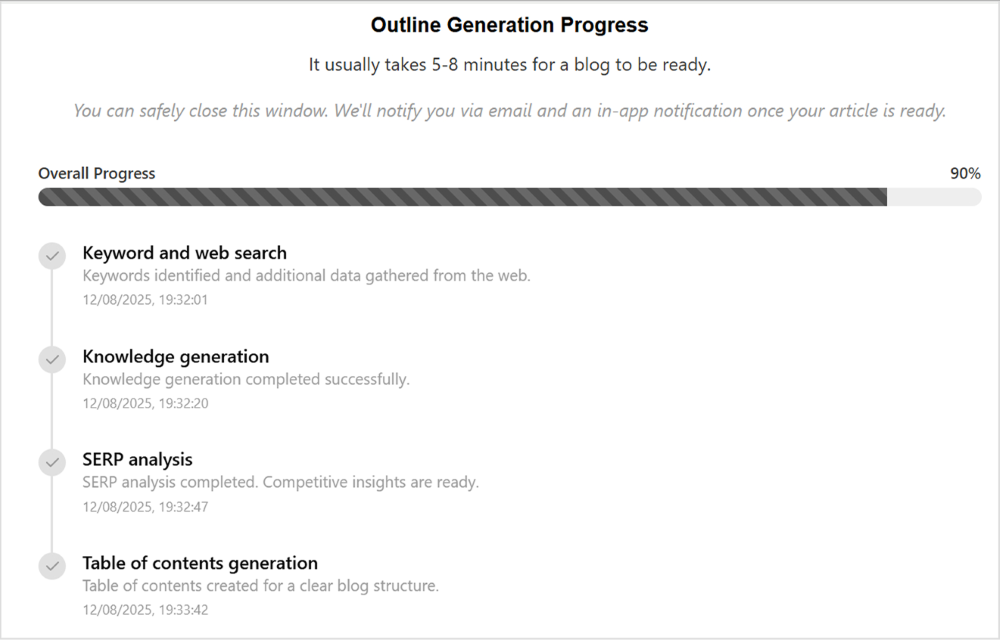
Related: How to create articles in bulk using Contentpen?
Step 4: Refine and finalize your blog post
The refinement phase transforms good AI-generated content into exceptional, publish-ready material. Review each section for accuracy, brand alignment, and value proposition clarity while ensuring all SEO elements are properly optimized.
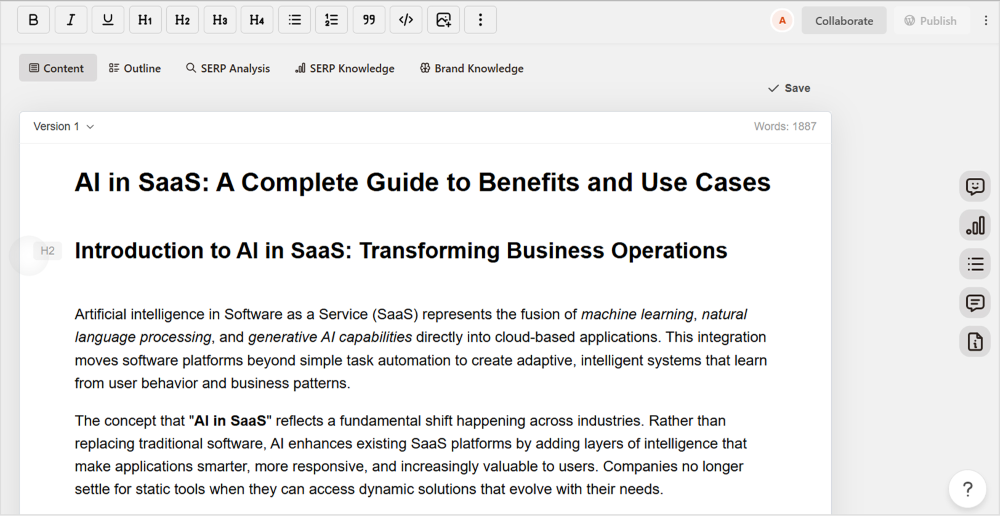
Content enhancement includes fact-checking statistics and claims, adding personal insights that differentiate your content from competitors, and ensuring smooth transitions between sections that improve readability and user experience.
Optimize meta elements, including title tags, meta descriptions, and image alt text, to maximize SERP performance. Contentpen provides suggestions for these elements, but manual review ensures they align perfectly with your content and brand messaging.
Step 5: Export and publish
The final step involves Contentpen’s publishing integrations to streamline content deployment across your digital platforms. The platform maintains formatting, internal links, and SEO elements during the export process, eliminating common technical issues.
Post-publication monitoring through integrated analytics helps track performance metrics and identify opportunities for content updates or promotion strategies that maximize long-term SEO value.
Also read: How to fact-check AI-generated content in 7 steps?
Tips for maximizing SEO results with Contentpen
Advanced users can unlock even greater value from Contentpen through strategic optimization techniques that compound SEO benefits over time. These approaches transform individual articles into comprehensive content strategies.
Use the tone options to match your brand voice
Brand voice consistency across all content creates stronger brand recognition and improves user engagement metrics that influence search rankings. Contentpen’s tone customization features should be calibrated to match your existing successful content and audience preferences.
Experiment with different tone settings for various content types and audience segments. B2B technical content might require authoritative expertise, while consumer-focused articles benefit from conversational accessibility. The platform’s flexibility accommodates these variations while maintaining overall brand coherence.
Document your preferred tone settings and style guidelines to ensure consistency across team members and content types. This systematic approach creates a distinctive brand voice that readers recognize and trust, improving both direct engagement and SEO performance.
Related: How to use tone of voice in writing?
Experiment with different outlines to suit your audience
Content structure optimization significantly impacts both user experience and search engine evaluation. Use Contentpen’s outline generator to test different approaches for similar topics, identifying structures that resonate most effectively with your specific audience.
Analyze performance data from different outline styles to understand what formats drive the best engagement metrics. Some audiences prefer comprehensive, encyclopedia-style coverage, while others respond better to practical, step-by-step guides or comparative analyses.
Teams can use Contentpen presets to standardize their most effective content formats and maintain consistency across all publications.

Always add your personal touch before publishing
While Contentpen produces excellent foundational content, human enhancement remains crucial for creating truly exceptional material that stands out in competitive markets. Your unique insights, experiences, and expertise transform good AI content into remarkable thought leadership.
Add personal anecdotes, case studies, and industry observations that demonstrate authentic expertise and provide value unavailable elsewhere. These human elements create the unique value proposition that search engines increasingly prioritize in their ranking algorithms.
Conclusion
Contentpen represents the evolution of AI-powered content creation, specifically engineered for businesses that refuse to compromise between SEO performance and content quality. It’s a comprehensive approach to SEO-rich blog content creation that includes everything from research and outlining through optimization and publishing.
eliminates the fragmented workflow that hampers most content marketing efforts.
Unlike generic AI writing tools that require extensive manual optimization, Contentpen integrates SEO best practices throughout the entire content creation process.
So, are you ready to transform your content marketing strategy? Start your journey with Contentpen’s AI blog writer today and discover why leading businesses choose it as their best AI tool for writing SEO-rich blog content. Your future search rankings will thank you!
Frequently asked questions
Contentpen is specifically built for SEO-rich content creation, featuring integrated keyword research, competitor analysis, automated internal linking, and real-time optimization guidance. Unlike generic AI writers, it understands search intent and structures content for both user engagement and search engine performance.
Absolutely! Contentpen’s guided workflow and real-time SEO suggestions make it accessible for beginners while providing advanced features for experienced marketers. The platform includes educational tooltips and best practice recommendations that help users learn SEO principles while creating content.
Most users report 60-80% time savings compared to traditional content creation. The platform handles research, outline generation, initial drafts, and SEO optimization automatically, allowing you to focus on adding unique insights and brand-specific elements.
Yes, Contentpen adapts to various industries through its brand voice learning capabilities and semantic understanding. The platform works effectively for B2B, e-commerce, technology, healthcare, finance, and other sectors by customizing tone, terminology, and content structure for specific audiences.
You might be interested in...

Is AI the future of blog writing services?
Traditional blog writing services face their biggest disruption yet. With generative AI tools producing content in seconds, businesses are questioning whether they still need human writers. AI writing tools have transformed from niche curiosities to mainstream business solutions practically overnight. Content agencies report a common refrain from clients: “Why should we pay for human writers […]
Aug 5, 2025

AI blogs vs human blogs: Which creates better content in 2025?
The debate between AI blogs vs human blogs has reached a tipping point. With AI tools for content creation becoming more popular and advanced, businesses are questioning whether they should stick with human writers or embrace artificial intelligence for their content strategy. Studies indicate that 88% of marketers are already relying on AI to handle […]
Jul 14, 2025

Will AI replace writers? The truth behind the hype
The digital landscape is buzzing with excitement and anxiety about AI writing tools. From Contentpen’s intelligent content generation to ChatGPT’s conversational prowess and Jasper’s marketing copy expertise, artificial intelligence has stormed into the writing world with impressive capabilities. This technological leap forward has sparked a burning question that keeps writers awake at night: Will AI […]
Jun 19, 2025